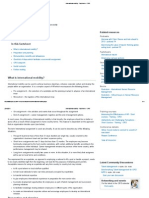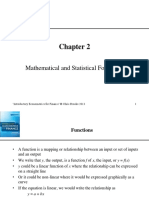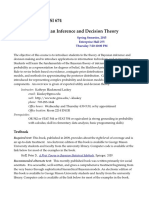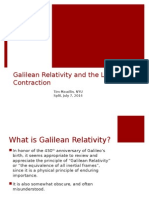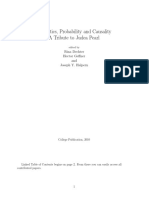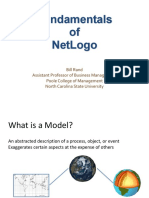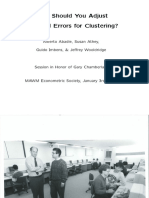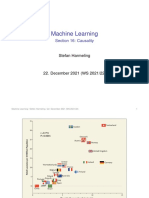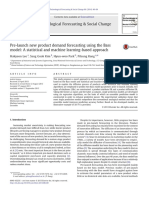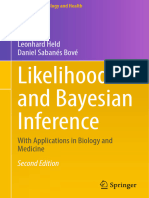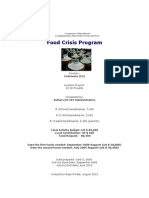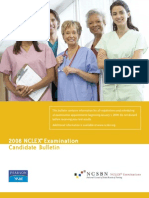Summary Book (Decision Analysis For Management Judgment)
Summary Book (Decision Analysis For Management Judgment)
Uploaded by
Sufian TanCopyright:
Available Formats
Summary Book (Decision Analysis For Management Judgment)
Summary Book (Decision Analysis For Management Judgment)
Uploaded by
Sufian TanOriginal Description:
Original Title
Copyright
Available Formats
Share this document
Did you find this document useful?
Is this content inappropriate?
Copyright:
Available Formats
Summary Book (Decision Analysis For Management Judgment)
Summary Book (Decision Analysis For Management Judgment)
Uploaded by
Sufian TanCopyright:
Available Formats
MM 5010 Strategic Decision Making & Negotiation
MBA - ITB
CHAPTER 6 (SIX)
Decision trees and influence diagrams can be extremely useful in helping people to gain an understanding of the structure of the problems which confront them. Decision problems are multi-stage in character when the choice of a given option may result in circumstances which will require yet another decision to be made. Decision trees can serve a number of purposes when complex multi-stage problems are encountered. They can help a decision maker to develop a clear view of the structure of a problem and make it easier to determine the possible scenarios which can result if a particular course of action is chosen. This can lead to creative thinking and the generation of options which were not previously being considered. Decision trees can also help a decision maker to judge the nature of the information which needs to be gathered in order to tackle a problem and, because they are generally easy to understand, they can be an excellent medium for communicating one persons perception of a problem to other individuals. Influence diagrams offer an alternative way of structuring a complex decision problem and some analysts find that people relate to them much more easily. Influence diagrams can be converted to decision trees and we will therefore regard them in this chapter as a method for eliciting decision trees.
Constructing a decision tree A square is used to represent a decision node and, because each branch emanating from this node presents an option, the decision maker can choose which branch to follow. A circle, on the other hand, is used to represent a chance node. The branches emanating from a circle are therefore labeled with probabilities which represent the decision makers estimate of the probability that a particular branch will be followed.
SUFIAN (29112017) X-47
Page 1
MM 5010 Strategic Decision Making & Negotiation
MBA - ITB
Determining the optimal policy It can be seen that our decision tree consists of a set of policies. A policy is a plan of action stating which option is to be chosen at each decision node that might be reached under that policy. The technique for determining the optimal policy in a decision tree is known as the rollback method. To apply this method, we analyze the tree from right to left by considering the later decisions first. It can be seen that the rollback method allows a complex decision problem to be analyzed as a series of smaller decision problems.
Decision trees involving continuous probability distributions The method is based on earlier work by Pearson and Tukey and requires three estimates to be made by the decision maker: (i) The value in the distribution which has a 95% chance of being exceeded. This value is allocated a probability of 0.185. (ii) The value in the distribution which has a 50% chance of being exceeded. This value is allocated a probability of 0.63. (iii) The value in the distribution which has only a 5% chance of being exceeded. This value is also allocated a probability of 0.185. Nevertheless, in general, there are clear advantages in using this approximation. Above all, it is simple and each distribution requires only three estimates to be made which has the obvious effect of reducing the decision makers judgmental task.
Assessment of decision structure It is really a matter of the decision analysts judgment as to whether the elicited tree is a fair representation of the decision makers decision problem. Once a structure is agreed then the computation of expected utility is fairly straightforward. The figure below presents a description
SUFIAN (29112017) X-47
Page 2
MM 5010 Strategic Decision Making & Negotiation
MBA - ITB
of the typical phases in a decision analysis of a problem that the decision maker wishes to resolve with help of the practitioner of decision analysis the decision analyst.
Eliciting decision tree representations What methods have been developed to help elicit decision tree representations from decision makers? One major method, much favored by some decision analysts, is that of influence diagrams which are designed to summarize the dependencies that are seen to exist among events and acts within a decision.
SUFIAN (29112017) X-47
Page 3
MM 5010 Strategic Decision Making & Negotiation
MBA - ITB
In addition, influence diagrams are more easily revised and altered as the decision maker iterates with the decision analyst. Decision trees, because of their strict temporal ordering of acts and events, need completely respecifying when additional acts and events are inserted into preliminary representations. One step-by-step procedure for turning an influence diagram into a decision tree is as follows: (1) Identify a node with no arrows pointing into it (since there can be no loops at least one node will be such). (2) If there is a choice between a decision node and an event node, choose the decision node. (3) Place the node at the beginning of the tree and remove the node from the influence diagram. (4) For the now-reduced diagram, choose another node with no arrows pointing into it. If there is a choice a decision node should be chosen. (5) Place this node next in the tree and remove it from the influence diagram. (6) Repeat the above procedure until all the nodes have been removed from the influence diagram.
Finally, we analyzed the process of generating decision tree representation of decision problems and advocated the influence diagram as a key technique to facilitate decision structuring.
SUFIAN (29112017) X-47
Page 4
MM 5010 Strategic Decision Making & Negotiation
MBA - ITB
CHAPTER 8 (EIGHT)
Bayes theorem Bayes theorem will be used as a normative tool, telling us how we should revise our probability assessments when new information becomes available. In Bayes theorem an initial probability estimate is known as a prior probability. The steps in the process are summarized below: (1) Construct a tree with branches representing all the possible events which can occur and write the prior probabilities for these events on the branches. (2) Extend the tree by attaching to each branch a new branch which represents the new information which you have obtained. On each branch write the conditional probability of obtaining this information given the circumstance represented by the preceding branch. (3) Obtain the joint probabilities by multiplying each prior probability by the conditional probability which follows it on the tree. (4) Sum the joint probabilities. (5) Divide the appropriate joint probability by the sum of the joint probabilities to obtain the required posterior probability.
The effect of new information on the revision of probability judgments It is interesting to explore the relative influence which prior probabilities and new information have on the resulting posterior probabilities. At the extreme, if your prior probability of an event occurring is zero then the posterior probability will also be zero. Whatever new information you receive, no matter how reliable it is, you will still refuse to accept that the event is possible. In general, assigning prior probabilities of zero or one is unwise. Ironically, if the new information has less than a 0.5 chance of being reliable its result is of interest and the more unreliable it is, the greater the effect it will have on the prior probability.
SUFIAN (29112017) X-47
Page 5
MM 5010 Strategic Decision Making & Negotiation
MBA - ITB
Applying Bayes theorem to a decision problem This simply involves the use of the posterior probabilities, rather than the prior probabilities, in the decision model.
Assessing the value of new information New information can remove or reduce the uncertainty involved in a decision and thereby increase the expected payoff. However, in many circumstances it may be expensive to obtain information since it might involve, for example, the use of scientific tests, the engagement of the services of a consultant or the need to carry out a market research survey.
The expected value of perfect information In many decision situations it is not possible to obtain perfectly reliable information, but nevertheless the concept of the expected value of perfect information (EVPI) can still be useful. We emphasize that our calculations are based on the assumption that the decision maker is risk neutral. If the manager is risk averse or risk seeking or if he also has non-monetary objectives then it may be worth him paying more or less than this amount.
The expected value of imperfect information As with the expected value of perfect information, we will need to consider the possible indications the test will give, what the probabilities of these indications are and the decision the manager should take in the light of a given indication. A summary of the main stages is given below: (1) Determine the course of action which would be chosen using only the prior probabilities and record the expected payoff of this course of action; (2) Identify the possible indications which the new information can give;
SUFIAN (29112017) X-47
Page 6
MM 5010 Strategic Decision Making & Negotiation
MBA - ITB
(3) For each indication: (a) Determine the probability that this indication will occur; (b) Use Bayes theorem to revise the probabilities in the light of this indication; (c) Determine the best course of action in the light of this indication (i.e. using the posterior probabilities) and the expected payoff of this course of action; (4) Multiply the probability of each indication occurring by the expected payoff of the course of action which should be taken if that indication occurs and sum the resulting products. This will give the expected payoff with imperfect information; (5) The expected value of the imperfect information is equal to the expected payoff with imperfect information (derived in stage 4) less the expected payoff of the course of action which would be selected using the prior probabilities There is an alternative way of looking at the value of information. New information can be regarded as being of no value if you would still make the same decision regardless of what the information told you.
Practical considerations Clearly, it is easier to identify the expected value of perfect as opposed to imperfect information, and we recommend that, in general, calculating the EVPI should be the first step in any information-evaluation exercise. The EVPI can act as a useful screen, since some sources of information may prove to be too expensive, even if they were to offer perfectly reliable data, which is unlikely. In most cases, however, the assessment of the reliability of the information will ultimately be based on the decision makers subjective judgment. The inputs required by the decision maker are: (1) the maximum loss which will need to be incurred before the product is removed from the market, (2) the probability of incurring this loss if the product is introduced, (3) the probability that the product will be successful, if introduced and (4) the probability that the market research will accurately predict the true state of the market.
SUFIAN (29112017) X-47
Page 7
MM 5010 Strategic Decision Making & Negotiation
MBA - ITB
CHAPTER 9 (NINE)
Most of the methods that are designed to help people to make decisions under conditions of uncertainty require estimates of probabilities for the possible outcomes of the decision. Because of the unavailability of suitable statistical data, these probabilities will usually be subjective estimates based on human judgment.
Heuristics and biases Much of the research on the quality of human judgment of probability has stemmed from the work of Tversky and Kahneman. The central theme of Tversky and Kahnemans work is that people use rules of thumb or heuristics to cope with the complexities of making estimates of probabilities. Three main heuristics identified by Tversky and Kahneman are (i) availability, (ii) representativeness and (iii) anchoring and adjustment.
The availability heuristic People using the availability heuristic therefore judge the probability of the occurrence of events by how easily these events are brought to mind. Availability can be a reliable heuristic. Frequently occurring events are usually easier to recall so the higher probabilities estimates for them should be reliable. For example, some events are easily recalled precisely because they are unusual and rare. This can lead to biased estimates. Biases associated with the availability heuristic 1. When ease of recall is not associated with probability Easily recalled events are not necessarily highly probable. 2. Ease of imagination is not related to probability Easily imagined events are not necessarily highly probable. 3. Illusory correlation
SUFIAN (29112017) X-47
Page 8
MM 5010 Strategic Decision Making & Negotiation
MBA - ITB
In decision analysis models, illusory correlation is of concern when conditional probabilities.
The representativeness heuristic If you use the representativeness heuristic you will answer questions by judging how representative the object, person or event is of the category or process. Biases associated with the representativeness heuristic 1. Ignoring base-rate frequencies 2. Expecting sequences of events to appear random 3. Expecting chance to be self-correcting 4. Ignoring regression to the mean 5. The conjunction fallacy
The anchoring and adjustment heuristic Judgment is widely used to make estimates of values such as how long a job will take to complete or what next months sales level will be. Often these estimates start with an initial value which is then adjusted to obtain the final estimate. Typical initial values might be how long the last job took to complete or this months level of sales. Unfortunately, the adjustment from these initial values is often insufficient; a phenomenon known as anchoring. Biases associated with anchoring and adjustment 1. Insufficient adjustment In decision making, anchoring can be a problem in the estimation of costs, payoffs and probabilities. Forecasts that are used in the decision process may be biased by forecasters anchoring on the current value and making insufficient adjustment for the effect of future conditions. 2. Overestimating the probability of conjunctive events
SUFIAN (29112017) X-47
Page 9
MM 5010 Strategic Decision Making & Negotiation
MBA - ITB
Typical examples might be: the main machine and the back-up machine both fail today or you get promoted and win the lottery and write a best-selling novel all within the next 12 months. Each of the individual events which might co-occur is called an elementary event. The tendency of people to overestimate probabilities for conjunctive events may therefore lead to unjustified optimism that the project will succeed. 3. Underestimating probabilities for disjunctive events When asked to estimate the probability of a disjunctive event it appears that, once again, people anchor on one of the elementary events. With disjunctive events this leads to a tendency to underestimate the probability. Since the estimation of risk often involves probability assessments for disjunctive events, this bias can be a serious concern. 4. Overconfidence It appears that overconfidence is most marked when people lack expertise or knowledge about the quantity they are estimating. People with expertise or relevant knowledge tend not to be overconfident, and they may even have a tendency to be under confident.
Other judgmental biases 1. Believing desirable outcomes are more probable Much research has suggested that people tend to view desirable outcomes as more probable than those which are undesirable. 2. Biased assessment of covariation Several researchers have found that a similar bias can occur when people are presented with tables showing the number of times that events either occurred or failed to occur together
Is human probability judgment really so poor? Over the last decade much of the work on heuristics and biases has been questioned. Most criticisms have centered on the fact that the research has largely been based on
SUFIAN (29112017) X-47
Page 10
MM 5010 Strategic Decision Making & Negotiation
MBA - ITB
inexperienced decision makers carrying out artificial tasks in psychological laboratories, rather than real-world decision makers making real decisions. 1. Subjects in studies may be unrepresentative of real decision makers 2. Laboratory tasks may be untypical of real-world problems 3. Tasks may be misunderstood by subjects 4. Subjects may be poorly motivated 5. Citation bias 6. Real world studies suggest better performance 7. People think in terms of frequencies not probabilities
A methodology for choosing how to develop a subjective probability assessment
SUFIAN (29112017) X-47
Page 11
You might also like
- 5S Monthly Audit ChecklistDocument6 pages5S Monthly Audit ChecklistZahid Hussain50% (2)
- Urban BatsDocument192 pagesUrban BatsKátia FacureNo ratings yet
- Efficacy of Mobile App-Based Interactive Cognitive Behavioral Therapy UsingDocument8 pagesEfficacy of Mobile App-Based Interactive Cognitive Behavioral Therapy UsingHomebbeautyNo ratings yet
- International Mobility - Factsheets - CIPDDocument11 pagesInternational Mobility - Factsheets - CIPDAbdKareemNo ratings yet
- CAPITAL ADEQUACY BEYOND BASEL Banking, Securities, and InsuranceDocument354 pagesCAPITAL ADEQUACY BEYOND BASEL Banking, Securities, and Insurancetarekmn1100% (1)
- Summary of A Beautiful Mind MovieDocument1 pageSummary of A Beautiful Mind MovieSufian TanNo ratings yet
- Ge'S Jeff Immelt: The Voyage From Mba To Ceo: Syndicate 5 (X-47)Document22 pagesGe'S Jeff Immelt: The Voyage From Mba To Ceo: Syndicate 5 (X-47)Sufian Tan100% (1)
- Summay Chapter 6 and 8 (Paul Goodwin and George Wright)Document10 pagesSummay Chapter 6 and 8 (Paul Goodwin and George Wright)Zulkifli SaidNo ratings yet
- Batanero Borovcnik Statistics and Probability in High School Contents PrefaceDocument8 pagesBatanero Borovcnik Statistics and Probability in High School Contents PrefaceTatu Dávila EgasNo ratings yet
- Mathematical and Statistical FoundationsDocument60 pagesMathematical and Statistical FoundationsderghalNo ratings yet
- SyllabusDocument3 pagesSyllabus2fast4lyfNo ratings yet
- UntitledDocument270 pagesUntitledElenaIordanNo ratings yet
- The Geometry of Changing Beliefs: A Complete Breakdown of The Bayes TheoremDocument26 pagesThe Geometry of Changing Beliefs: A Complete Breakdown of The Bayes TheoremHafsa JahanNo ratings yet
- Applied EconometricsDocument74 pagesApplied EconometricsHenry Pham100% (1)
- Causal InferenceDocument15 pagesCausal InferenceAfifNo ratings yet
- Correlation Is Not CausationDocument15 pagesCorrelation Is Not CausationGlen GilchristNo ratings yet
- From Probability To Consilience How Explanatory Values Implement BayesianReasoninDocument13 pagesFrom Probability To Consilience How Explanatory Values Implement BayesianReasoninSaber VegNo ratings yet
- Small Island Ecosystems: Ekologi Laut Tropis 2015 Tim EkolaDocument20 pagesSmall Island Ecosystems: Ekologi Laut Tropis 2015 Tim EkolaRIFALDINo ratings yet
- Handbook of Data Based Decision Making in EducationDocument511 pagesHandbook of Data Based Decision Making in Educationafoplistis2No ratings yet
- Theory of Deep Learning 1652786371Document118 pagesTheory of Deep Learning 1652786371Washington AzevedoNo ratings yet
- Harsanyi Morality and The Theory of Rational BehaviourDocument13 pagesHarsanyi Morality and The Theory of Rational BehaviourAdelvan OliverioNo ratings yet
- An Introduction To The BootstrapDocument7 pagesAn Introduction To The Bootstraphytsang123No ratings yet
- global-state-of-drones-2024Document19 pagesglobal-state-of-drones-2024venkatpraveens2006No ratings yet
- Maudlin - Galilean Relativity and Lorenzian ContractionDocument30 pagesMaudlin - Galilean Relativity and Lorenzian ContractionDamir Đirlić100% (1)
- A Briefer History of Time PicturesDocument40 pagesA Briefer History of Time PicturesSagar DuwalNo ratings yet
- Grinstead C.M, Peterson W.P, Snell J.L. - (2011) Probability TalesDocument250 pagesGrinstead C.M, Peterson W.P, Snell J.L. - (2011) Probability TalesOscar Reynaga AlarcónNo ratings yet
- Complexity and The Economy Brian ArthurDocument5 pagesComplexity and The Economy Brian Arthurmederic1108100% (1)
- BOOK - Heuristics, Probability and Causality - A Tribute To Judea PearlDocument573 pagesBOOK - Heuristics, Probability and Causality - A Tribute To Judea PearlBruno BritoNo ratings yet
- Complex Systems A SurveyDocument10 pagesComplex Systems A SurveyRafael Soares PintoNo ratings yet
- Cognitive Psychology - (Philosophy of Mind) Gary F Marcus - The Algebraic Mind - Ch1 - Cognitive ArchitDocument6 pagesCognitive Psychology - (Philosophy of Mind) Gary F Marcus - The Algebraic Mind - Ch1 - Cognitive ArchitFrancis Proulx100% (1)
- 7 Pillars of Stat Wisdom PDFDocument38 pages7 Pillars of Stat Wisdom PDFreub33No ratings yet
- CACM Communications of ACM 2019 March 03Document124 pagesCACM Communications of ACM 2019 March 03Theodor StanescuNo ratings yet
- BI 10 HurisDocument47 pagesBI 10 HurisThiran VinharNo ratings yet
- Tijms - Chance, Logic and IntuitionDocument254 pagesTijms - Chance, Logic and Intuitionjosber2007No ratings yet
- CarlZeiss T Coating PDFDocument77 pagesCarlZeiss T Coating PDFParagNo ratings yet
- Classic Topics on the History of Modern Mathematical Statistics: From Laplace to More Recent TimesFrom EverandClassic Topics on the History of Modern Mathematical Statistics: From Laplace to More Recent TimesNo ratings yet
- The Law of Excluded Middle-Neil CooperDocument21 pagesThe Law of Excluded Middle-Neil CooperMari VojvodovicNo ratings yet
- Uneconomic Growth - Herman DalyDocument15 pagesUneconomic Growth - Herman DalyWanessa SantiagoNo ratings yet
- Nicholas Rescher - Epistemetrics (2006)Document126 pagesNicholas Rescher - Epistemetrics (2006)Muhammad Aulia Ihza100% (1)
- Important Mathematicians in The Optimization FieldDocument122 pagesImportant Mathematicians in The Optimization FieldlupoderiNo ratings yet
- Beyond Prediction Using Big Data For Policy ProblemsDocument4 pagesBeyond Prediction Using Big Data For Policy ProblemsLilia XaNo ratings yet
- National Sports Governance Observer 2 Final ReportDocument322 pagesNational Sports Governance Observer 2 Final ReportJOEL MUÑOZ100% (1)
- (Springer Series in Statistics) Jun Shao, Dongsheng Tu (Auth.) - The Jackknife and Bootstrap-Springer-Verlag New York (1995)Document532 pages(Springer Series in Statistics) Jun Shao, Dongsheng Tu (Auth.) - The Jackknife and Bootstrap-Springer-Verlag New York (1995)sherlockholmes108100% (1)
- Artificial Intelligence and Machine Learning (21CS54) Module - 1Document13 pagesArtificial Intelligence and Machine Learning (21CS54) Module - 1Balaji YalburgiNo ratings yet
- What AI Means For Economics - by IMFDocument81 pagesWhat AI Means For Economics - by IMFtamlqNo ratings yet
- Fundamentals of NetlogoDocument30 pagesFundamentals of NetlogoFlávia Cardoso Pereira Dos SantosNo ratings yet
- Package Fextremes': September 20, 2011Document37 pagesPackage Fextremes': September 20, 2011Carlos Eduardo MatosNo ratings yet
- Using Credit Wisely PDFDocument36 pagesUsing Credit Wisely PDFSDNo ratings yet
- Presentation On Inflation: Presented By: Darwin Balabbo ManaguelodDocument13 pagesPresentation On Inflation: Presented By: Darwin Balabbo ManaguelodJulius MacaballugNo ratings yet
- PHD Thesis Bernardo R C Costa Lima Final SubmissionDocument204 pagesPHD Thesis Bernardo R C Costa Lima Final SubmissionSohaib ShamsiNo ratings yet
- Optimal Regulation ProcessesDocument21 pagesOptimal Regulation ProcessescastrojpNo ratings yet
- Diff in Diff Uk12 VillaDocument16 pagesDiff in Diff Uk12 Villapcg20013793No ratings yet
- Information Theory Is The New Central DisciplineDocument3 pagesInformation Theory Is The New Central DisciplinebambambholeNo ratings yet
- Conway - On Unsettleable Arithmetical ProblemsDocument8 pagesConway - On Unsettleable Arithmetical ProblemsfreafreafreaNo ratings yet
- When Should You Adjust Standard Errors For Clustering?: Alberto Abadie, Susan Athey, Guido Imbens, & Jeffrey WooldridgeDocument33 pagesWhen Should You Adjust Standard Errors For Clustering?: Alberto Abadie, Susan Athey, Guido Imbens, & Jeffrey WooldridgesreedharbharathNo ratings yet
- ML Section16 CausalityDocument57 pagesML Section16 CausalitydummyNo ratings yet
- Causal Inference and Stable Learning: Peng Cui Tong ZhangDocument95 pagesCausal Inference and Stable Learning: Peng Cui Tong ZhangPrudhvi BNo ratings yet
- What Are The Chances of That - How To Think About UncertaintyDocument383 pagesWhat Are The Chances of That - How To Think About Uncertaintyellagalan22No ratings yet
- Technological Forecasting & Social Change: Hakyeon Lee, Sang Gook Kim, Hyun-Woo Park, Pilsung KangDocument16 pagesTechnological Forecasting & Social Change: Hakyeon Lee, Sang Gook Kim, Hyun-Woo Park, Pilsung KangSuryateja MerguNo ratings yet
- Marketing Research: MRKT 451 Experimentation IDocument41 pagesMarketing Research: MRKT 451 Experimentation IAnkit SaxenaNo ratings yet
- Intro To Spiking Neural NetworksDocument10 pagesIntro To Spiking Neural NetworksjeffconnorsNo ratings yet
- A Path Planning AlgorithmDocument13 pagesA Path Planning Algorithmpi194043100% (1)
- Likelihood An Bayesian ExpDocument409 pagesLikelihood An Bayesian ExpPabloNaviaVergaraNo ratings yet
- Report SimprojectDocument16 pagesReport SimprojectSufian TanNo ratings yet
- IBM Vision and ValuesDocument11 pagesIBM Vision and ValuesSufian Tan100% (1)
- Buying Ahouse BATNADocument12 pagesBuying Ahouse BATNASufian TanNo ratings yet
- MPPA (Financial Statement Analysis)Document36 pagesMPPA (Financial Statement Analysis)Sufian TanNo ratings yet
- Is Sony Turning Around - (Strategic Leadership)Document16 pagesIs Sony Turning Around - (Strategic Leadership)Sufian TanNo ratings yet
- Chapter 1 To 4 Business StrategyDocument15 pagesChapter 1 To 4 Business StrategySufian TanNo ratings yet
- Summary of Chapter 2 and Reading Material (Case Study)Document5 pagesSummary of Chapter 2 and Reading Material (Case Study)Sufian TanNo ratings yet
- Proposal For Food Crisis ProgramDocument15 pagesProposal For Food Crisis ProgramSufian TanNo ratings yet
- Sufian Corning Inc.Document7 pagesSufian Corning Inc.Sufian TanNo ratings yet
- Sparking Creativity at FerrariDocument3 pagesSparking Creativity at FerrariSufian TanNo ratings yet
- Report SimprojectDocument16 pagesReport SimprojectSufian TanNo ratings yet
- Cendant Shareholder Attack Executive PayDocument10 pagesCendant Shareholder Attack Executive PaySufian TanNo ratings yet
- Lessons Learned at MethodDocument4 pagesLessons Learned at MethodSufian Tan100% (1)
- English 3 AdjectivesDocument3 pagesEnglish 3 AdjectivesMiss Lana A.No ratings yet
- Ekarma IndiaDocument6 pagesEkarma Indiae karmaNo ratings yet
- CV ChristyDocument8 pagesCV ChristySUNNYWAY CONSTRUCTIONNo ratings yet
- KA3936Document5 pagesKA3936Lakshmi PriyaNo ratings yet
- List of Countries by Human Development Index - WikipediaDocument37 pagesList of Countries by Human Development Index - Wikipediananiuday1118No ratings yet
- Bhuvaneswari DeviDocument4 pagesBhuvaneswari DeviSylvesterJuniorNo ratings yet
- Group 6 Statistic Final ProjectDocument19 pagesGroup 6 Statistic Final ProjectTrần Lam Nhi NguyễnNo ratings yet
- Vanuatu 2030 - The People's Plan National Sustainable Development Plan 2016 To 2030 - Nov 2016Document28 pagesVanuatu 2030 - The People's Plan National Sustainable Development Plan 2016 To 2030 - Nov 2016Seni NabouNo ratings yet
- Trader's MindsetDocument24 pagesTrader's Mindsetwork.filmsbyaishNo ratings yet
- Closing Prayer Graduation AecDocument2 pagesClosing Prayer Graduation AecVangie SalvacionNo ratings yet
- Lesson Plan SuperlativeDocument7 pagesLesson Plan SuperlativejosiasNo ratings yet
- Biniam Worku Assignment 1Document5 pagesBiniam Worku Assignment 1Bini Teflon AnkhNo ratings yet
- 6508 Assignment 2Document15 pages6508 Assignment 2Engr Saud shahNo ratings yet
- Calloway AW NeedsAssessment 8462Document35 pagesCalloway AW NeedsAssessment 8462Ashley CallowayNo ratings yet
- AMT Explained PDFDocument1 pageAMT Explained PDFbranwell COGO100% (1)
- Learn Cbse: Maths Mcqs For Class 12 With Answers Chapter 1 Relations and FunctionsDocument12 pagesLearn Cbse: Maths Mcqs For Class 12 With Answers Chapter 1 Relations and FunctionsSanjayNo ratings yet
- NCLEXDocument43 pagesNCLEXkagandaHON0% (1)
- Exam DefintionDocument4 pagesExam DefintionMwangi PeterNo ratings yet
- Tata Consultancy Services LimitedDocument21 pagesTata Consultancy Services Limitedsanjeev kumar100% (1)
- Entrepreneurship: Quarter 2: Module 2Document21 pagesEntrepreneurship: Quarter 2: Module 2Karyl Dianne B. LaurelNo ratings yet
- Images of Children, Crime and Violence in Playboy, Penthouse, and Hustler - Full ReportDocument260 pagesImages of Children, Crime and Violence in Playboy, Penthouse, and Hustler - Full ReportJudith Reisman, Ph.D.100% (2)
- Q3 Week 1. Jan 31-Feb 1 2024Document3 pagesQ3 Week 1. Jan 31-Feb 1 2024RONA BLANCA G. BRIONESNo ratings yet
- Syllabus International and Regional HumaDocument54 pagesSyllabus International and Regional Humachemo1987No ratings yet
- (Utah Series in Turkish and Islamic Stud) Meir Hatina-'Ulama', Politics, and The Public Sphere - An Egyptian Perspective - University of Utah Press (2010)Document257 pages(Utah Series in Turkish and Islamic Stud) Meir Hatina-'Ulama', Politics, and The Public Sphere - An Egyptian Perspective - University of Utah Press (2010)syeduop3510No ratings yet
- Mother Tongue To Enchance Language Performance of Grade Seven Students of Juan G. Macaraeg National HighschoolDocument19 pagesMother Tongue To Enchance Language Performance of Grade Seven Students of Juan G. Macaraeg National HighschoolAbhey Abellera BarcenaNo ratings yet
- DIRECTIONS: Choose The Letter of The Best Answer. Write Your Answer On A SeparateDocument2 pagesDIRECTIONS: Choose The Letter of The Best Answer. Write Your Answer On A SeparateMary Grace Manaeg HerederoNo ratings yet
- CMCO Training BrochureDocument16 pagesCMCO Training BrochuresugiyantoNo ratings yet
- Dissertation On Social IssuesDocument6 pagesDissertation On Social IssuesBuySchoolPapersOnlineLowell100% (1)



